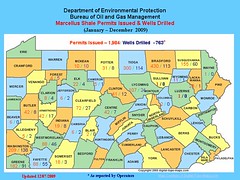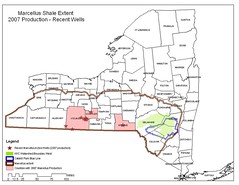State wastewater regulations for natural gas drilling may change to reduce pollution threat.
By Rory Sweeney rsweeney@timesleader.comStaff Writer
TimesLeader.com
November 27, 2009
Anyone concerned with pollution threats from increased natural gas drilling in Pennsylvania has likely encountered the phrase, “total dissolved solids” and recognizes its potential to be a problem.
However, fewer no doubt know how it can become a problem or that – because of issues emerging from the increased drilling – the state Department of Environmental Protection is considering changes to wastewater discharge standards for TDS that would become effective Jan. 1, 2011.
DEP is seeking public comment on the proposals, and citizens have until Feb. 5 to make them. Earlier this month, Penn State University released a document to help people understand the issues and participate in the process.
Rather than a specific chemical, TDS is a measurement of all dissolved matter – such as minerals, salts and metals – in a given water sample and can be naturally occurring. The federal safe drinking-water standard has a recommended level of 500 milligrams per liter for TDS, but no specific regulation. However, concentrations above that can damage treatment equipment and be toxic to aquatic life and people who drink it.
DEP is proposing the changes, which would limit the TDS levels in wastewater discharges, because it determined that some state waterways, including the West Branch of the Susquehanna River, don’t have the ability to absorb increased levels of TDS.
According to the Penn State report, most of the water used to prepare gas wells – often called “frack water” – is between 800 milligrams per liter and 300,000 milligrams per liter.
The industry estimates the amount of such high-TDS wastewater needing disposal in Pennsylvania will increase from about 9 million gallons per day in 2009 to nearly 20 million gallons per day by 2011, the report said.
DEP’s proposal would change two parts of state code.
First, it would require high-TDS discharges to be diluted to at least 500 milligrams per liter, plus lower thresholds for sulfates and chlorides and, for the oil and gas industry, limits of 10 milligrams per liter for strontium and barium.
Second, it would change water-quality standards for the actual waterway, which would, in turn, affect what could be discharged into it. That regulation change hasn’t yet been officially proposed.
To comment on the proposed rules, the Penn State report recommends several approaches: be specific in citing documents or the target of the comment, stick to comments on the proposed rule rather than water-quality in general, include personal experiences and note where the proposed rules are written unclearly.
LINK to TimesLeader article.
DEMAND ACCOUNTABILITY!



















No comments:
Post a Comment